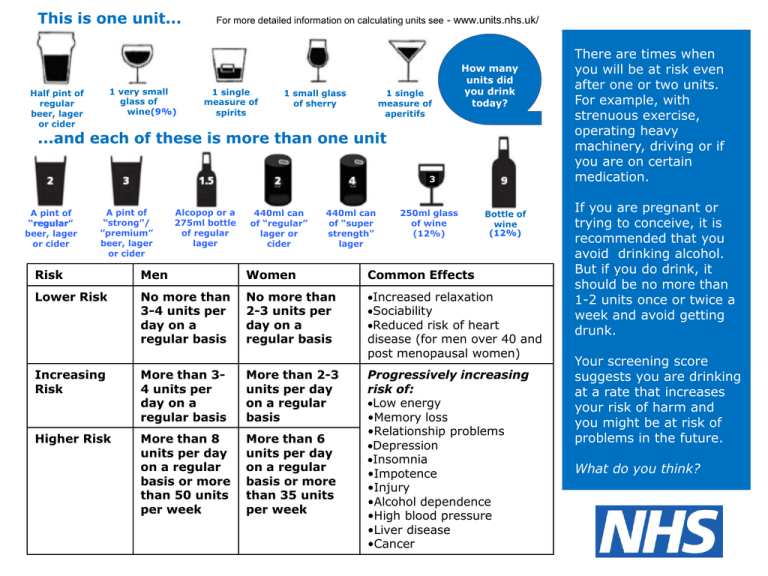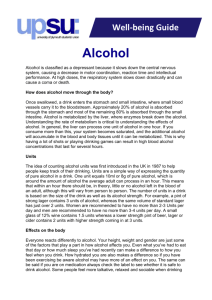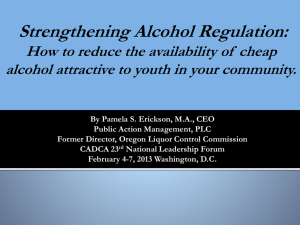Structured Brief Advice Tool
advertisement

This is one unit... 1 very small glass of wine(9%) Half pint of regular beer, lager or cider For more detailed information on calculating units see - www.units.nhs.uk/ 1 single measure of spirits 1 small glass of sherry 1 single measure of aperitifs How many units did you drink today? ...and each of these is more than one unit 3 A pint of regular “regular” beer, lager or cider A pint of “strong”/ ”premium” beer, lager or cider Alcopop or a 275ml bottle of regular lager 440ml can of “regular” lager or cider 440ml can of “super strength” lager 250ml glass of wine (12%) Bottle of wine (12%) Risk Men Women Common Effects Lower Risk No more than 3-4 units per day on a regular basis No more than 2-3 units per day on a regular basis Increased relaxation Sociability Reduced risk of heart disease (for men over 40 and post menopausal women) Increasing Risk More than 34 units per day on a regular basis More than 2-3 units per day on a regular basis Higher Risk More than 8 units per day on a regular basis or more than 50 units per week More than 6 units per day on a regular basis or more than 35 units per week Progressively increasing risk of: Low energy •Memory loss •Relationship problems Depression Insomnia •Impotence •Injury •Alcohol dependence •High blood pressure •Liver disease •Cancer There are times when you will be at risk even after one or two units. For example, with strenuous exercise, operating heavy machinery, driving or if you are on certain medication. If you are pregnant or trying to conceive, it is recommended that you avoid drinking alcohol. But if you do drink, it should be no more than 1-2 units once or twice a week and avoid getting drunk. Your screening score suggests you are drinking at a rate that increases your risk of harm and you might be at risk of problems in the future. What do you think? The benefits of cutting down What’s everyone else like? % of Adult Population Population by Risk Category 70.0% 60.0% 50.0% 40.0% Male Female 30.0% 20.0% 10.0% What targets should you aim for? 0.0% Abstaining Low er risk Making your plan • • • • • • • • • Psychological/Social/Financial •Improved mood •Improved relationships •Reduced risks of drink driving •Save money Physical •Sleep better •More energy •Lose weight •No hangovers •Reduced risk of injury •Improved memory •Better physical shape •Reduced risk of high blood pressure •Reduced risk of cancer •Reduced risks of liver disease •Reduced risks of brain damage Increasing risk Higher risk When bored or stressed have a workout instead of drinking Avoid going to the pub after work Plan activities and tasks at those times you would usually drink When you do drink, set yourself a limit and stick to it Have your first drink after starting to eat Quench your thirst with non-alcohol drinks before and in-between alcoholic drinks Avoid drinking in rounds or in large groups Switch to low alcohol beer/lager Avoid or limit the time spent with “heavy” drinking friends Men Should not regularly drink more than 3–4 units of alcohol a day. Women Should not regularly drink more than 2–3 units a day ‘Regularly’ means drinking every day or most days of the week. You should also take a break for 48 hours after a heavy session to let your body recover. What is your personal target? This brief advice is based on the “How Much Is Too Much?” Simple Structured Advice Intervention Tool, developed by Newcastle University and the Drink Less materials originally developed at the University of Sydney as part of a W.H.O. collaborative study.











